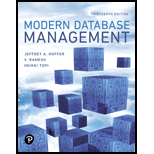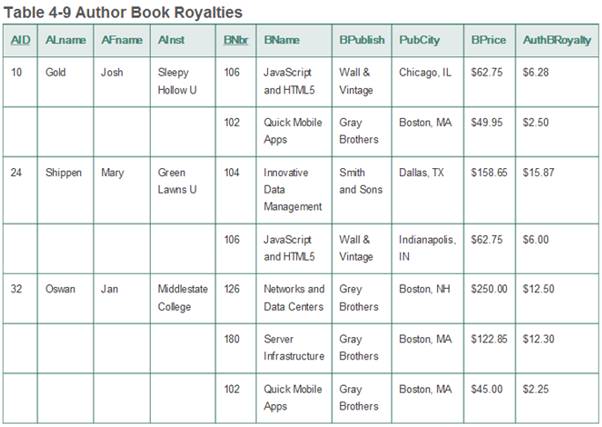
Concept explainers
Explore the data included in Table 4-9.

Assume that the primary key of this relation consists of two components: Author's ID (AID) and Book number (BNbr). The relation includes data regarding authors, books, and publishers. In addition, it tells what an individual author's per book royalty amount is in the case of multi-authored books. Your task is to:
- Identify the functional dependencies between the attributes.
- Identify the normal form in which the relation currently is.
- Identify the errors in the data that have been made possible by its poor structural characteristics.
- Take the actions (if any) necessary to convert the relation into the third normal form. Identify all intermediate steps.
Learn your wayIncludes step-by-step video

Chapter 4 Solutions
Pearson eText for Modern Database Management -- Instant Access (Pearson+)
Additional Engineering Textbook Solutions
Introduction To Programming Using Visual Basic (11th Edition)
Mechanics of Materials (10th Edition)
Java: An Introduction to Problem Solving and Programming (8th Edition)
Web Development and Design Foundations with HTML5 (8th Edition)
Electric Circuits. (11th Edition)
Starting Out with Java: From Control Structures through Data Structures (4th Edition) (What's New in Computer Science)
- Exercise docID document text docID document text 1 hot chocolate cocoa beans 7 sweet sugar 2345 9 cocoa ghana africa 8 sugar cane brazil beans harvest ghana 9 sweet sugar beet cocoa butter butter truffles sweet chocolate 10 sweet cake icing 11 cake black forest Clustering by k-means, with preprocessing tokenization, term weighting TFIDF. Manhattan Distance. Number of cluster is 2. Centroid docID 2 and docID 9.arrow_forwardChange the following code so that there is always at least one way to get from the left corner to the top right, but the labyrinth is still randomized. The player starts at the bottom left corner of the labyrinth. He has to get to the top right corner of the labyrinth as fast he can, avoiding a meeting with the evil dragon. Take care that the player and the dragon cannot start off on walls. Also the dragon starts off from a randomly chosen position public class Labyrinth { private final int size; private final Cell[][] grid; public Labyrinth(int size) { this.size = size; this.grid = new Cell[size][size]; generateLabyrinth(); } private void generateLabyrinth() { Random rand = new Random(); for (int i = 0; i < size; i++) { for (int j = 0; j < size; j++) { // Randomly create walls and paths grid[i][j] = new Cell(rand.nextBoolean()); } } // Ensure start and end are…arrow_forwardChange the following code so that it checks the following 3 conditions: 1. there is no space between each cells (imgs) 2. even if it is resized, the components wouldn't disappear 3. The GameGUI JPanel takes all the JFrame space, so that there shouldn't be extra space appearing in the frame other than the game. Main(): Labyrinth labyrinth = new Labyrinth(10); Player player = new Player(9, 0); Dragon dragon = new Dragon(9, 9); JFrame frame = new JFrame("Labyrinth Game"); GameGUI gui = new GameGUI(labyrinth, player, dragon); frame.add(gui); frame.setSize(600, 600); frame.setDefaultCloseOperation(JFrame.EXIT_ON_CLOSE); frame.setVisible(true); public class GameGUI extends JPanel { private final Labyrinth labyrinth; private final Player player; private final Dragon dragon; //labyrinth, player, dragon are just public classes private final ImageIcon playerIcon = new ImageIcon("data/images/player.png");…arrow_forward
- Make the following game user friendly with GUI, with some simple graphics. The GUI should be in another seperate class, with some ImageIcon, and Game class should be added into the pane. The following code works as this: The objective of the player is to escape from this labyrinth. The player starts at the bottom left corner of the labyrinth. He has to get to the top right corner of the labyrinth as fast he can, avoiding a meeting with the evil dragon. The player can move only in four directions: left, right, up or down. There are several escape paths in all labyrinths. The player’s character should be able to moved with the well known WASD keyboard buttons. If the dragon gets to a neighboring field of the player, then the player dies. Because it is dark in the labyrinth, the player can see only the neighboring fields at a distance of 3 units. Cell Class: public class Cell { private boolean isWall; public Cell(boolean isWall) { this.isWall = isWall; } public boolean isWall() { return…arrow_forwardDiscuss the negative and positive impacts or information technology in the context of your society. Provide two references along with with your answerarrow_forwardA cylinder of diameter 10 cm rotates concentrically inside another hollow cylinder of inner diameter 10.1 cm. Both cylinders are 20 cm long and stand with their axis vertical. The annular space is filled with oil. If a torque of 100 kg cm is required to rotate the inner cylinder at 100 rpm, determine the viscosity of oil. Ans. μ= 29.82poisearrow_forward
- Make the following game user friendly with GUI, with some simple graphics The following code works as this: The objective of the player is to escape from this labyrinth. The player starts at the bottom left corner of the labyrinth. He has to get to the top right corner of the labyrinth as fast he can, avoiding a meeting with the evil dragon. The player can move only in four directions: left, right, up or down. There are several escape paths in all labyrinths. The player’s character should be able to moved with the well known WASD keyboard buttons. If the dragon gets to a neighboring field of the player, then the player dies. Because it is dark in the labyrinth, the player can see only the neighboring fields at a distance of 3 units. Cell Class: public class Cell { private boolean isWall; public Cell(boolean isWall) { this.isWall = isWall; } public boolean isWall() { return isWall; } public void setWall(boolean isWall) { this.isWall = isWall; } @Override public String toString() {…arrow_forwardPlease original work What are four of the goals of information lifecycle management think they are most important to data warehousing, Why do you feel this way, how dashboards can be used in the process, and provide a real life example for each. Please cite in text references and add weblinksarrow_forwardThe following is code for a disc golf program written in C++: // player.h #ifndef PLAYER_H #define PLAYER_H #include <string> #include <iostream> class Player { private: std::string courses[20]; // Array of course names int scores[20]; // Array of scores int gameCount; // Number of games played public: Player(); // Constructor void CheckGame(int playerId, const std::string& courseName, int gameScore); void ReportPlayer(int playerId) const; }; #endif // PLAYER_H // player.cpp #include "player.h" #include <iomanip> Player::Player() : gameCount(0) {} void Player::CheckGame(int playerId, const std::string& courseName, int gameScore) { for (int i = 0; i < gameCount; ++i) { if (courses[i] == courseName) { // If course has been played, then check for minimum score if (gameScore < scores[i]) { scores[i] = gameScore; // Update to new minimum…arrow_forward
- In this assignment, you will implement a multi-threaded program (using C/C++) that will check for Prime Numbers and Palindrome Numbers in a range of numbers. Palindrome numbers are numbers that their decimal representation can be read from left to right and from right to left (e.g. 12321, 5995, 1234321). The program will create T worker threads to check for prime and palindrome numbers in the given range (T will be passed to the program with the Linux command line). Each of the threads works on a part of the numbers within the range. Your program should have some global shared variables: • numOfPrimes: which will track the total number of prime numbers found by all threads. numOfPalindroms: which will track the total number of palindrome numbers found by all threads. numOfPalindromic Primes: which will count the numbers that are BOTH prime and palindrome found by all threads. TotalNums: which will count all the processed numbers in the range. In addition, you need to have arrays…arrow_forwardHow do you distinguish between hardware and a software problem? Discuss theprocedure for troubleshooting any hardware or software problem. give one reference with your answer.arrow_forwardYou are asked to explain what a computer virus is and if it can affect computer’shardware or software. How do you protect your computer against virus? give one reference with your answer.arrow_forward
 Database Systems: Design, Implementation, & Manag...Computer ScienceISBN:9781305627482Author:Carlos Coronel, Steven MorrisPublisher:Cengage Learning
Database Systems: Design, Implementation, & Manag...Computer ScienceISBN:9781305627482Author:Carlos Coronel, Steven MorrisPublisher:Cengage Learning
